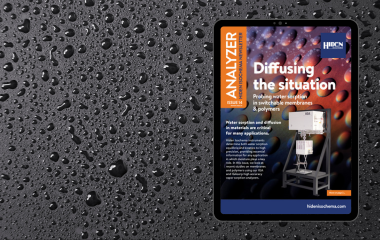Understanding Ionic Liquid Gas Separation
Ionic liquids, often referred to as “liquid salts”, have garnered significant attention in the realm of gas separation. Their unique properties, distinct from conventional solvents, make them a promising candidate for various applications. As the demand for efficient gas separation techniques grows, the role of ionic liquids in this domain becomes increasingly pivotal.
Molecular-level Understanding
Ionic liquids, with their unique molecular structures, have emerged as a focal point in gas separation. These liquids, distinct from traditional solvents, have cations and anions that developers can tailor to specific applications (i.e. supported membranes in gas separation)[1].
Understanding these molecular structures is an enduring challenge. However, advanced computational methods are showing results in this arena. Quantitative structure-property relationships (QSPRs) are a powerful tool for elucidating the relationship between an ionic liquids’ molecular structure and macroscopic properties. This can help researchers predict the liquid’s behaviour in gas separation processes[2].
In essence, the molecular-level understanding of ionic liquids is about recognising their potential and decoding their behaviour.
Gas Transport Properties
Ionic liquids play a crucial role in gas separation applications. Imidazolium-based ionic liquids have emerged as a prominent category. This heightened interest results from their ability to separate acidic gases, such as carbon dioxide (CO2) and hydrogen sulphide (H2S), from their mixtures[3].
Imidazolium-based ionic liquids owe their gas separation capabilities to their unique structural attributes. The presence of acetate counter-ions enhances the solubility of acidic gases. This is attributed to the formation of carbene species, which facilitates the physical absorption of the gas molecules. Moreover, the tunability of the alkyl chain length in the imidazolium cation allows for the optimisation of viscosity and density, further influencing the gas transport properties.
Poly(ionic liquid)-based membranes represent another frontier in the gas separation domain. These membranes combine the advantageous properties of polymers and ionic liquids, enhancing selectivity and permeability. Specifically, they have demonstrated a notable proficiency in separating CO2 from other gases, such as nitrogen (N2) and methane (CH4)[4]. The mechanism behind this is twofold: the ionic liquid component aids in the dissolution of CO2, while the polymeric matrix provides the necessary mechanical strength and stability.
Furthermore, these ionic liquids’ thermal and chemical stability ensures their longevity, even under challenging conditions. This makes them particularly suitable for industrial applications where consistent performance over extended periods is crucial.
Composite Materials and Their Role
The fusion of ionic liquids with other materials, particularly porous ones, has ushered in a new era of gas separation and catalysis innovation. This synergy capitalises on the strengths of both components, resulting in materials with enhanced properties and functionalities.
Graphene possesses remarkable mechanical strength, electrical conductivity, and a vast surface area. When combined with ionic liquids, the resultant composite material exhibits augmented gas separation capabilities[5]. The liquid imbues the graphene matrix with increased selectivity, while graphene provides structural integrity and high surface area for gas adsorption. This makes the composite especially adept at separating gas mixtures with similar molecular sizes or polarities.
Beyond graphene, integrating ionic liquids with other porous materials, such as metal-organic frameworks (MOFs) and zeolites, is also gaining traction. These composites benefit from the high porosity and tunable pore sizes of the porous materials, coupled with the unique solvation properties of the ionic liquids.
Catalysis has also benefited from the transformative impact of these composites. Techniques like supported ionic liquid phase (SILP) and solid catalysts with ionic liquid layers (SCILL) are at the forefront of this revolution[6]. In SILP, an ultrathin layer of ionic liquid is immobilised on a solid support, providing a liquid-like environment for catalytic reactions. This ensures high catalyst activity while facilitating easy separation of products. SCILL, on the other hand, involves the deposition of ionic liquid layers on solid catalysts, enhancing their stability and performance. These techniques not only improve the efficiency of catalytic processes but also extend the lifespan of the catalysts.
Interested in Sorption Analyzers?
At Hiden Isochema, we recognise the importance of understanding gas interactions with materials like ionic liquids.The gravimetric technique is an ideal method for measuring the interaction of gases or vapours with ionic liquids. Both the magnitude of solubility, and the rate of diffusion is measured directly. Our XEMIS series, known for its precision and reproducibility, is unparalleled in high-pressure sorption analysis. With the capability to handle flammable, corrosive, and toxic gases and vapours, the XEMIS series can effectively measure gas solubility in ionic liquids. For those in the know, the future of gas separation lies in harnessing the power of ionic liquids. Dive deeper into our offerings and the world of ionic liquids here.
References:
- Mohammadi, M., Asadollahzadeh, M., & Shirazian, S. (2018). Molecular-level understanding of supported ionic liquid membranes for gas separation. Journal of Molecular Liquids.
- Toots KM, Sild S, Leis J, Acree WE Jr, Maran U. Machine Learning Quantitative Structure-Property Relationships as a Function of Ionic Liquid Cations for the Gas-Ionic Liquid Partition Coefficient of Hydrocarbons. Int J Mol Sci. 2022 Jul 7;23(14):7534. doi: 10.3390/ijms23147534. PMID: 35886881; PMCID: PMC9323540.
- Akhmetshina AI, Yanbikov NR, Atlaskin AA, Trubyanov MM, Mechergui A, Otvagina KV, Razov EN, Mochalova AE, Vorotyntsev IV. Acidic Gases Separation from Gas Mixtures on the Supported Ionic Liquid Membranes Providing the Facilitated and Solution-Diffusion Transport Mechanisms. Membranes (Basel). 2019 Jan 5;9(1):9. doi: 10.3390/membranes9010009. PMID: 30621273; PMCID: PMC6359326.
- Bernardo G, Gaspar H. Recent Advances in Poly(Ionic Liquid)-Based Membranes for CO2 Separation. Polymers (Basel). 2023 Jan 28;15(3):667. doi: 10.3390/polym15030667. PMID: 36771968; PMCID: PMC9920068.
- Zhou H, Bai S, Zhang Y, Xu D, Wang M. Recent Advances in Ionic Liquids and Ionic Liquid-Functionalized Graphene: Catalytic Application and Environmental Remediation. Int J Environ Res Public Health. 2022 Jun 21;19(13):7584. doi: 10.3390/ijerph19137584. PMID: 35805238; PMCID: PMC9325325.
- Perdikaki, A.V., Vangeli, O.C., Karanikolos, G.N., Stefanopoulos, K.L., Beltsios, K.G., Alexandridis, P., Kanellopoulos, N.K., & Romanos, G.E. (2012). Ionic liquid-modified porous materials for gas separation and heterogeneous catalysis. Journal of Physical Chemistry C, 116, 16398-16411.


